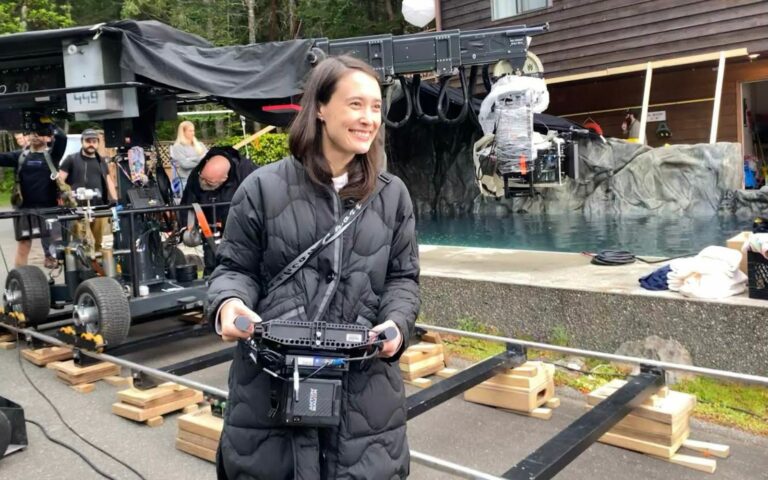By Prabhjot Bains
Théodore Pellerin plays the year’s most chilling character in Lurker, a film that peels back the toxic economy of fame and obsession.

Meredith Hama-Brown was pulling off business glam when we met at a cafe in downtown Toronto, a pop of blue eye-liner elevating an already chic grey blazer. It was early September and the Toronto International Film Festival was well underway, with tens of thousands of filmgoers, filmmakers, industry execs and press pouring through a few cinemas from 8am till 3am. Half an hour with Hama-Brown, much like her debut film Seagrass, was a breath of fresh air, a welcome calm from the chaos.
Hama-Brown’s road to filmmaking was paved with intent and intuition, and her approach to her craft abides by a similar principle. She was drawn to movies by their unparalleled ability, across the storytelling mediums, to foster relationships. “I just feel like there’s so much connection that can be found through making films,” she tells RANGE. “I talk about personal, deep-rooted themes and so for me to be able to share those with other people is very special.”
Seagrass centres on relationships, those between a family of four at a couples’ therapy retreat, the people they meet that test an already fraught marriage, and the ghosts of generations past. Emotionally stunted alpha-male Steve (Luke Roberts, Game of Thrones) fumbles as his wife Judith (Ally Maki, Shortcomings) questions her identity as a wife, a mother, and a Japanese-Canadian whose parent endured imprisonment in an internment camp, while their two daughters, 11-year-old Stephanie (Nyha Breitkreuz) and six-year-old Emmy (Remy Marthaller), suffer the unintended consequences of the rifts that came before them. Hama-Brown weaves a delicate web within the interior life of a family, their vulnerabilities and incomprehensible emotions.
But connections lie beyond a film’s themes, and Hama-Brown discovered deeper bonds to her personal history and broader community making Seagrass. She hesitated at first to tell this story because much of the history and culture on her Japanese Canadian side had been lost. “It’s something that I longed to be more connected to, but it feels lost in a sense,” she shares. “But then as I started to write this, it was a beautiful experience because I started to connect with other Japanese Canadians and I realised we all sort of feel this way.”

“There’s been so much that has been lost and really robbed, and it’s because of this displacement and this dispossession and incarceration” she continues. “It fractured the entire community and it created, I think, a lot of shame for my grandparents’ generation, a lot of pain, and so it was something that they didn’t want to discuss. So to me, it’s special to talk about this because it’s already allowed me to have so much more connection with the Japanese Canadian community and other Asian Canadians and Americans who might relate in other ways.”
Though Seagrass explores relationships with frayed edges, its creation was an act of repair. Films don’t need a hopeful or clear message for audiences to feel closer to life, to themselves, or to others. Hama-Brown is particularly drawn to open-ended stories that explore people rather than plot. “I wanted to show a family going through this potential divorce, but I didn’t want the central question to be whether they would stay together or not,” she explains. “I wanted it to be: how was it going to affect each of these characters in a more profound way?”
Hama-Brown worked with long-time collaborator Norm Li (The Body Remembers When The World Broke Open) to develop a visual language that complemented that ambiguity. Li captures Gabriola Island, Tofino, and Ucluelet on lush 35 mm, juxtaposing the sunny skies with the dark sea. They filmed the adults with a distant, static camera to convey a stale and cold mindset, whereas they shot the daughters on handheld to get swept up in their intense, solitary worlds. A third cinematic style dips and sways like the ocean, inferring the presence of the past. The pair sought a syntax that felt “unique to them” and successfully developed an aesthetic unparalleled in the Canadian cannon.
Hama-Brown’s skills layer broad-scale themes within the intimate scope of a family. She brings patience and respect to her process, holding space, allowing complex truths to emerge in the interstice. She writes and directs with intuition, a task that requires honesty with oneself and an open mind, but is ultimately one path that leads true artists to their calling.
Seagrass premieres Feb. 23 in select cinemas in Toronto, Montreal, Vancouver, Victoria, Quebec City, Kelowna, Winnipeg, and Sudbury.
Meredith Hama-Brown will be in attendance for a Q&A Feb. 25 at 2:30 at TIFF Lightbox.

By Prabhjot Bains
Théodore Pellerin plays the year’s most chilling character in Lurker, a film that peels back the toxic economy of fame and obsession.
By Ben Boddez
The Winnipeg rocker herself speaks on Jennifer Abbott and Pollyanna Hardwicke-Brown’s new career-spanning documentary.
By Prabhjot Bains
Forget the plot and bask in Ethan Coen’s small-town hodgepodge of dry humour and eccentric personalities.